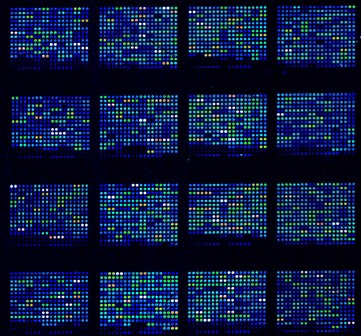User login
ORLANDO – Chromosomal microarray testing is ideal for narrowing down the diagnosis in most patients presenting with multiple congenital anomalies, according to Dr. Laurie Demmer.
"Microarray is the clinical geneticist’s favorite test right now. We order it every day – anytime we see somebody with multiple congenital anomalies, unless it’s obviously Down syndrome or another obvious syndrome," Dr. Demmer said during a "Genetic Testing Boot Camp" session at the annual meeting of the American Academy of Pediatrics.
For children presenting with a suspected syndrome, problems with growth, or a development or autism spectrum disorder, microarray is "really our go-to test right now," said Dr. Demmer, a pediatric clinical geneticist at Levine Children’s Hospital, Charlotte, N.C.
Also, if chromosomal testing demonstrates a certain karyotype, such as a translocation, then microarray testing is the best approach for determining if it is a balanced translocation. If a marker chromosome is detected, microarray will identify it.
Like karyotyping, which is often used when a chromosomal anomaly is suspected, microarray testing provides a look at the whole genome, but it is about 100 times more sensitive than a karyotype. It is high resolution like fluorescent in situ hybridization (FISH), which is a chromosomal testing method often used when a quicker answer is needed to help guide management.
Thus, microarray testing is "kind of the best of both worlds," Dr. Demmer said, adding that with microarray analysis, it is possible to look for small deletions and duplications on all the chromosomes within the whole genome.
At first, microarray testing was targeted; rather than looking at the whole genome, testing was performed to look for known syndromes such as 22q deletions and Williams syndrome and Smith-Magenis syndrome, for example. Expanding the view to the whole genome has allowed for diagnosis of new syndromes that were never known before.
"Every week I get one or two arrays back that are abnormal with a new deletion or duplication that I’d never seen or heard of before," she said, noting that a downside of this is that there’s no clear answer to what should be done with all of these "copy number variants." Currently they are being characterized in databases as a reference.
The latest generation of microarray testing (single nucleotide polymorphism, or SNP array) provides qualitative information not available with oligoarray testing.
"It allows us to tell the difference between chromosomes. ... It gives us the ability to tell if there is identity in the chromosomes," she said, explaining that this may mean identifying uniparental disomy (and likely Prader-Willi syndrome), consanguinity (and degree of relationship), and other circumstances associated with autosomal recessive disease.
A downside of microarray testing is that it only looks for deletions and duplications, and therefore does not detect balanced rearrangements. Thus a balanced translocation will not be detected on microarray testing, and an opportunity for genetic counseling could be missed.
Also, sometimes a copy number variant or deletion or duplication is found, and it is unclear how these should be interpreted.
A general rule of thumb, however, is that the bigger it is, the more likely it is to be significant, Dr. Demmer said, noting that in some of these cases, the parents are tested, and if a parent has the same copy number variant but is normal, the finding is usually a benign change.
Sometimes, however, a parent who has the copy number variant may be "on the spectrum somewhere, but not actually diagnosed, and they may have one of the changes associated with autism."
These cases require special care in interpretation, Dr. Demmer said. "If you’re going to send out for microarrays in your office and it comes back normal, that’s great, but if it comes back anything else, you may want to get a geneticist to help you," she said.
Similarly, unanticipated results – incidental findings – also occur, and these can be tricky to deal with. Examples include cases of unknown consanguinity and incest, she said.
Sometimes the incidental findings lead to improved outcomes. Dr. Demmer described one case involving an intellectually disabled 10-year-old girl who was incidentally found on microarray testing to be at genetic risk for familial adenomatous polyposis (FAP). A gastrointestinal examination showed that she already had thousands of polyps.
"So she has FAP, which we diagnosed by doing the microarray, and probably saved her life, because now we will treat her, and we’re going to prevent the colon cancer," she said.
Dr. Demmer reported having no disclosures.
ORLANDO – Chromosomal microarray testing is ideal for narrowing down the diagnosis in most patients presenting with multiple congenital anomalies, according to Dr. Laurie Demmer.
"Microarray is the clinical geneticist’s favorite test right now. We order it every day – anytime we see somebody with multiple congenital anomalies, unless it’s obviously Down syndrome or another obvious syndrome," Dr. Demmer said during a "Genetic Testing Boot Camp" session at the annual meeting of the American Academy of Pediatrics.
For children presenting with a suspected syndrome, problems with growth, or a development or autism spectrum disorder, microarray is "really our go-to test right now," said Dr. Demmer, a pediatric clinical geneticist at Levine Children’s Hospital, Charlotte, N.C.
Also, if chromosomal testing demonstrates a certain karyotype, such as a translocation, then microarray testing is the best approach for determining if it is a balanced translocation. If a marker chromosome is detected, microarray will identify it.
Like karyotyping, which is often used when a chromosomal anomaly is suspected, microarray testing provides a look at the whole genome, but it is about 100 times more sensitive than a karyotype. It is high resolution like fluorescent in situ hybridization (FISH), which is a chromosomal testing method often used when a quicker answer is needed to help guide management.
Thus, microarray testing is "kind of the best of both worlds," Dr. Demmer said, adding that with microarray analysis, it is possible to look for small deletions and duplications on all the chromosomes within the whole genome.
At first, microarray testing was targeted; rather than looking at the whole genome, testing was performed to look for known syndromes such as 22q deletions and Williams syndrome and Smith-Magenis syndrome, for example. Expanding the view to the whole genome has allowed for diagnosis of new syndromes that were never known before.
"Every week I get one or two arrays back that are abnormal with a new deletion or duplication that I’d never seen or heard of before," she said, noting that a downside of this is that there’s no clear answer to what should be done with all of these "copy number variants." Currently they are being characterized in databases as a reference.
The latest generation of microarray testing (single nucleotide polymorphism, or SNP array) provides qualitative information not available with oligoarray testing.
"It allows us to tell the difference between chromosomes. ... It gives us the ability to tell if there is identity in the chromosomes," she said, explaining that this may mean identifying uniparental disomy (and likely Prader-Willi syndrome), consanguinity (and degree of relationship), and other circumstances associated with autosomal recessive disease.
A downside of microarray testing is that it only looks for deletions and duplications, and therefore does not detect balanced rearrangements. Thus a balanced translocation will not be detected on microarray testing, and an opportunity for genetic counseling could be missed.
Also, sometimes a copy number variant or deletion or duplication is found, and it is unclear how these should be interpreted.
A general rule of thumb, however, is that the bigger it is, the more likely it is to be significant, Dr. Demmer said, noting that in some of these cases, the parents are tested, and if a parent has the same copy number variant but is normal, the finding is usually a benign change.
Sometimes, however, a parent who has the copy number variant may be "on the spectrum somewhere, but not actually diagnosed, and they may have one of the changes associated with autism."
These cases require special care in interpretation, Dr. Demmer said. "If you’re going to send out for microarrays in your office and it comes back normal, that’s great, but if it comes back anything else, you may want to get a geneticist to help you," she said.
Similarly, unanticipated results – incidental findings – also occur, and these can be tricky to deal with. Examples include cases of unknown consanguinity and incest, she said.
Sometimes the incidental findings lead to improved outcomes. Dr. Demmer described one case involving an intellectually disabled 10-year-old girl who was incidentally found on microarray testing to be at genetic risk for familial adenomatous polyposis (FAP). A gastrointestinal examination showed that she already had thousands of polyps.
"So she has FAP, which we diagnosed by doing the microarray, and probably saved her life, because now we will treat her, and we’re going to prevent the colon cancer," she said.
Dr. Demmer reported having no disclosures.
ORLANDO – Chromosomal microarray testing is ideal for narrowing down the diagnosis in most patients presenting with multiple congenital anomalies, according to Dr. Laurie Demmer.
"Microarray is the clinical geneticist’s favorite test right now. We order it every day – anytime we see somebody with multiple congenital anomalies, unless it’s obviously Down syndrome or another obvious syndrome," Dr. Demmer said during a "Genetic Testing Boot Camp" session at the annual meeting of the American Academy of Pediatrics.
For children presenting with a suspected syndrome, problems with growth, or a development or autism spectrum disorder, microarray is "really our go-to test right now," said Dr. Demmer, a pediatric clinical geneticist at Levine Children’s Hospital, Charlotte, N.C.
Also, if chromosomal testing demonstrates a certain karyotype, such as a translocation, then microarray testing is the best approach for determining if it is a balanced translocation. If a marker chromosome is detected, microarray will identify it.
Like karyotyping, which is often used when a chromosomal anomaly is suspected, microarray testing provides a look at the whole genome, but it is about 100 times more sensitive than a karyotype. It is high resolution like fluorescent in situ hybridization (FISH), which is a chromosomal testing method often used when a quicker answer is needed to help guide management.
Thus, microarray testing is "kind of the best of both worlds," Dr. Demmer said, adding that with microarray analysis, it is possible to look for small deletions and duplications on all the chromosomes within the whole genome.
At first, microarray testing was targeted; rather than looking at the whole genome, testing was performed to look for known syndromes such as 22q deletions and Williams syndrome and Smith-Magenis syndrome, for example. Expanding the view to the whole genome has allowed for diagnosis of new syndromes that were never known before.
"Every week I get one or two arrays back that are abnormal with a new deletion or duplication that I’d never seen or heard of before," she said, noting that a downside of this is that there’s no clear answer to what should be done with all of these "copy number variants." Currently they are being characterized in databases as a reference.
The latest generation of microarray testing (single nucleotide polymorphism, or SNP array) provides qualitative information not available with oligoarray testing.
"It allows us to tell the difference between chromosomes. ... It gives us the ability to tell if there is identity in the chromosomes," she said, explaining that this may mean identifying uniparental disomy (and likely Prader-Willi syndrome), consanguinity (and degree of relationship), and other circumstances associated with autosomal recessive disease.
A downside of microarray testing is that it only looks for deletions and duplications, and therefore does not detect balanced rearrangements. Thus a balanced translocation will not be detected on microarray testing, and an opportunity for genetic counseling could be missed.
Also, sometimes a copy number variant or deletion or duplication is found, and it is unclear how these should be interpreted.
A general rule of thumb, however, is that the bigger it is, the more likely it is to be significant, Dr. Demmer said, noting that in some of these cases, the parents are tested, and if a parent has the same copy number variant but is normal, the finding is usually a benign change.
Sometimes, however, a parent who has the copy number variant may be "on the spectrum somewhere, but not actually diagnosed, and they may have one of the changes associated with autism."
These cases require special care in interpretation, Dr. Demmer said. "If you’re going to send out for microarrays in your office and it comes back normal, that’s great, but if it comes back anything else, you may want to get a geneticist to help you," she said.
Similarly, unanticipated results – incidental findings – also occur, and these can be tricky to deal with. Examples include cases of unknown consanguinity and incest, she said.
Sometimes the incidental findings lead to improved outcomes. Dr. Demmer described one case involving an intellectually disabled 10-year-old girl who was incidentally found on microarray testing to be at genetic risk for familial adenomatous polyposis (FAP). A gastrointestinal examination showed that she already had thousands of polyps.
"So she has FAP, which we diagnosed by doing the microarray, and probably saved her life, because now we will treat her, and we’re going to prevent the colon cancer," she said.
Dr. Demmer reported having no disclosures.
EXPERT ANALYSIS FROM THE AAP NATIONAL CONFERENCE


